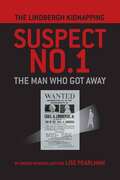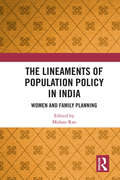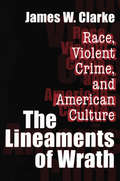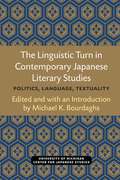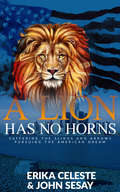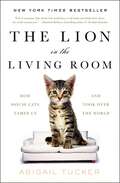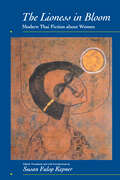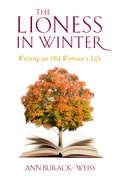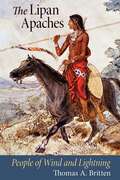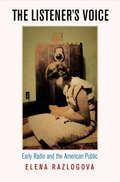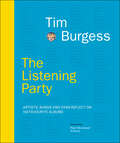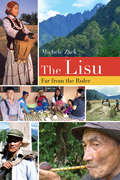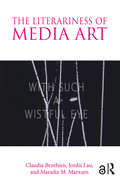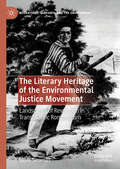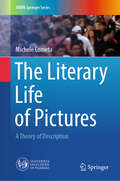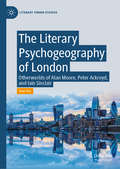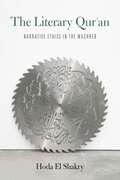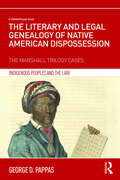- Table View
- List View
The Lindbergh Kidnapping Suspect No. 1: The Man Who Got Away
by Lise PearlmanAstonishingly more key evidence is accessible today than was presented at the death penalty trial of Bruno Richard Hauptmann for the kidnap/murder of Charles Lindbergh, Jr. Viewing documents and photos that the jury never saw and forensic analysis never before published, you get to judge for yourself who committed the "crime of the century." Experts and enthusiasts alike are calling award-winning author Lise Pearlman's shocking new exposé on the Lindbergh kidnapping: "MYTH-SMASHING, BEAUTIFULLY WRITTEN, POWERFULLY ARGUED" — Lloyd Gardner "SHOCKING...WELL-DOCUMENTED…HIGHLY PLAUSIBLE.” — Dr. William M. Bass "EXPERTLY RESEARCHED" "SUPERBLY CRAFTED" "MUST-READ" — Greg Ahlgren & Stephen Monier This shocking but true story is told in just 350 pages divided into dozens of short, riveting chapters you can’t put down. Bonus features include: -- scores of photos including what Little Charlie really looked like at the time he disappeared and other suppressed evidence -- the May 1932 forensic report issued by the premiere medical lab now known as Bristol Myers Squibb. -- modern forensic analysis of the corpse by a renowned pathologist published here for the first time -- 60+ pages of detailed endnotes for armchair detectives and curious readers -- source list of over 90+ books, archives and other reference materials -- comprehensive index, and more! In the depths of the Depression, millions worldwide followed every twist and turn of the Lindbergh baby kidnap/murder. Yet what was reported was largely fake news. Nearly a century after undocumented immigrant Bruno Richard Hauptmann was executed for the dastardly crime, questions still linger. If the wrong man was convicted, who did it? When? Why? Where? How? The shocking answers this book suggests have eluded all prior authors. Extensive research into dusty archives yielded crucial forensic evidence never before analyzed. Readers are invited to reexamine "the crime of the century" with fresh eyes focused on a key suspect - a slim man wearing a fedora that obscured his face. He was spotted with a ladder in his car near the Lindberghs' driveway early that fateful night. The police let an insider who fit that description oversee the entire investigation - the boy's father, international hero Charles Lindbergh. Abuse of power, amorality and xenophobia all feature in this saga set in an era dominated by white supremacists and social Darwinists. If Lindbergh was Suspect No. 1, the man who got away, what was his motive? Who else was involved? Who helped cover up the crime? Read this book and judge for yourself.
The Lineaments of Population Policy in India: Women and Family Planning
by Mohan RaoIndia is the first country in the world to have an official programme for family planning that commenced in 1952. It has also seen a strong women’s movement to assert reproductive and contraceptive rights. This book brings to the fore several contestations and negotiations between public policy and the women’s movement in India. The comprehensive volume puts together key documents from archival records and authoritative sources, and traces the contours that have marked and defined the population policy in India as well as rights issues for women. <P><P>A major intervention in the field, this book will be indispensable for scholars and researchers in public policy, public health, demography, gender studies, social policy, development studies, sociology, social justice, human rights, politics and those interested in the study of modern India.
The Lineaments of Wrath: Race, Violent Crime and American Culture
by James W. ClarkeViolence has marked relations between blacks and whites in America for nearly four hundred years. In The Lineaments of Wrath, James W. Clarke draws upon behavioral science theory and primary historical evidence to examine and explain its causes and enduring consequences.Beginning with slavery and concluding with the present, Clarke describes how the combined effects of state-sanctioned mob violence and the discriminatory administration of "race-blind" criminal and contract labor laws terrorized and immobilized the black population in the post-emancipation South. In this fashion an agricultural system, based on debt peonage and convict labor, quickly replaced slavery and remained the back-bone of the region's economy well into the twentieth century.Quoting the actual words of victims and witnesses from former slaves to "gangsta" rappers Clarke documents the erosion of black confidence in American criminal justice. In so doing, he also traces the evolution, across many generations, of a black subculture of violence, in which disputes are settled personally, and without recourse to the legal system. That subculture, the author concludes, accounts for historically high rates of black-on-black violence which now threatens to destroy the black inner city from within. The Lineaments of Wrath puts America's race issues into a completely original historical perspective. Those in the fields of political science, sociology, history, psychology, public policy, race relations, and law will find Clarke's work of profound importance.
The Linguistic Turn in Contemporary Japanese Literary Studies: Politics, Language, Textuality (Michigan Monograph Series in Japanese Studies #68)
by Michael K. BourdaghsThe 1970s and 1980s saw a revolution in Japanese literary criticism. A new generation of scholars and critics, many of them veterans of 1960s political activism, arose in revolt against the largely positivistic methodologies that had hitherto dominated postwar literary studies. Creatively refashioning approaches taken from the field of linguistics, the new scholarship challenged orthodox interpretations, often introducing new methodologies in the process: structuralism, semiotics, and phenomenological linguistics, among others. The radical changes introduced then continue to reverberate today, shaping the way Japanese literature is studied both at home and abroad. The Linguistic Turn in Contemporary Japanese Literary Studies is the first critical study of this revolution to appear in English. It includes translations of landmark essays published in the 1970s and 1980s by such influential figures as Noguchi Takehiko, Kamei Hideo, Mitani Kuniaki, and Hirata Yumi. It also collects nine new essays that reflect critically on the emergence of linguistics-based literary criticism and theory in Japan, exploring both the novel possibilities such theory created and the shortcomings that could not be overcome. Scholars from a variety of disciplines and fields probe the political and intellectual implications of this transformation and explore the exciting new pathways it opened up for the study of modern Japanese literature.
The Link: Uncovering Our Earliest Ancestor
by Colin Tudge Josh YoungFor more than a century, scientists have raced to unravel the human family tree and have grappled with its complications. Now, with an astonishing new discovery, everything we thought we knew about primate origins could change. Lying inside a high-security vault, deep within the heart of one of the world's leading natural history museums, is the scientific find of a lifetime--a perfectly fossilized early primate, older than the previously most famous primate fossil, Lucy, by an astonishing forty-four million years. A secret until now, the fossil--"Ida" to the researchers who have painstakingly verified her provenance--is the most complete primate fossil ever found. Forty-seven million years old, Ida rewrites what we've assumed about the earliest primate origins. Her completeness is unparalleled--so much of what we understand about evolution comes from partial fossils and even single bones, but Ida's fossilization offers much more than that, from a haunting "skin shadow" to her stomach contents. And, remarkably, knowledge of her discovery and existence almost never saw the light of day. With exclusive access to the first scientists to study her, the award-winning science writer Colin Tudge tells the history of Ida and her place in the world. A magnificent, cutting-edge scientific detective story followed her discovery, and The Link offers a wide-ranging investigation into Ida and our earliest origins. At the same time, it opens a stunningly evocative window into our past and changes what we know about primate evolution and, ultimately, our own.
The Lion Has No Horns: Suffering the Slings and Arrows Pursuing the American Dream
by Erika Celeste John SesayYoung man sets out to immigrate to America from North Africa but encounters and overcomes corrupt government officials and ruthless criminals in Africa but eventually gets to America and falls into the hands of human traffickers. He finally succeeds in finding his way into the mainstream flow of society where he finds the freedom to develop his potential as a complete human being.
The Lion in the Living Room: How House Cats Tamed Us and Took Over the World
by Abigail TuckerA New York Times bestseller about how cats conquered the world and our hearts in this &“deep and illuminating perspective on our favorite household companion&” (Huffington Post).House cats rule bedrooms and back alleys, deserted Antarctic islands, even cyberspace. And unlike dogs, cats offer humans no practical benefit. The truth is they are sadly incompetent mouse-catchers and now pose a threat to many ecosystems. Yet, we love them still. In the &“eminently readable and gently funny&” (Library Journal, starred review) The Lion in the Living Room, Abigail Tucker travels through world history, natural science, and pop culture to meet breeders, activists, and scientists who&’ve dedicated their lives to cats. She visits the labs where people sort through feline bones unearthed from the first human settlements, treks through the Floridian wilderness in search of house cats-turned-hunters on the loose, and hangs out with Lil Bub, one of the world&’s biggest celebrities—who just happens to be a cat. &“Fascinating&” (Richmond Times-Dispatch) and &“lighthearted&” (The Seattle Times), Tucker shows how these tiny felines have used their relationship with humans to become one of the most powerful animals on the planet. A &“lively read that pounces back and forth between evolutionary science and popular culture&” (The Baltimore Sun), The Lion in the Living Room suggests that we learn that the appropriate reaction to a house cat, it seems, might not be aww but awe.
The Lion's Whiskers
by Ann Grifalconi Nancy Raines DayIn this tale from the Amhara people of Ethiopia, a patient woman uses her experience with a wild lion to win the love of her new stepson.
The Lioness in Bloom: Modern Thai Fiction about Women (Voices from Asia #9)
by Susan Fulop KepnerKepner's selection shows the many ways fiction has mirrored the lives of Thai women over the twentieth century. The spectrum is broad, encompassing the young and the old, the rural and the cosmopolitan, the privileged and the poor. Some writers address previously unacceptable themes: female sexuality, spousal abuse, gender oppression. Others display a scintillating sense of humor. They touch on many themes—injustice, the heartlessness of society, loneliness, the difficult choices that life presents. Susan Kepner's lyrical, faithful translations preserve the tenor and resonances of these voices, many of which will be heard for the first time by English-speaking readers.
The Lioness in Winter: Writing an Old Woman's Life
by Ann Burack-WeissWhen she started working with the aged more than forty years ago, Ann Burack-Weiss began storing the knowledge and skills she thought would help when she got old herself. It was not until she hit her mid-seventies that she realized she had packed sneakers to climb Mount Everest, not anticipating the crevices and chasms that constitute the rocky terrain of old age. The professional gerontological and social work literature offered little help, so she turned to the late-life works of beloved women authors who had bravely climbed the mountain and sent back news from the summit. Maya Angelou, Colette, Simone de Beauvoir, Joan Didion, Marguerite Duras, M. F. K. Fisher, Doris Lessing, Mary Oliver, Adrienne Rich, May Sarton, and Florida Scott-Maxwell were among the many guides she turned to for inspiration. In The Lioness in Winter, Burack-Weiss blends an analysis of key writings from these and other famed women authors with her own wisdom to create an essential companion for older women and those who care for them. She fearlessly examines issues such as living with loss, finding comfort and joy in unexpected places, and facing disability and death. This book is filled with powerful passages from women who turned their experiences of aging into art, and Burack-Weiss ties their words to her own struggles and epiphanies, framing their collective observations with key insights from social work practice.
The Lipan Apaches: People of Wind and Lightning
by Thomas A. BrittenWinner of the 2010 Texas Old Missions and Forts Restoration Association Book AwardDespite the significant role they have played in Texas history for nearly four hundred years, the Lipan Apaches remain among the least studied and least understood tribal groups in the West. Considered by Spaniards of the eighteenth century to be the greatest threat to the development of New Spain's northern frontier, the Lipans were viewed as a similar risk to the interests of nineteenth-century Mexico, Texas, and the United States. Direct attempts to dissolve them as a tribal unit began during the Spanish period and continued with the establishment of the Republic of Texas in 1836. From their homeland in south Texas, Lipan migratory hunter-gatherer bands waged a desperate struggle to maintain their social and cultural traditions amidst numerous Indian and non-Indian enemies. Government officials, meanwhile, perceived them as a potential danger to the settlement and economic development of the Rio Grande frontier. Forced removal from their traditional homelands diminished their ability to defend themselves and, as they attached themselves to the Mescalero Apaches and the Tonkawas, the Lipans faded from written history in 1884. Thomas Britten has scoured U.S. and Mexican archives in order to piece together the tangled tribal history of these adaptable people, emphasizing the cultural change that coincided with the various migrations and pressures they faced. The result is an interdisciplinary study of the Lipan Apaches that focuses on their history and culture, their relationships with a wide range of Indian and non-Indian peoples, and their responses to the various crises and burdens that seemed to follow them wherever they went.
The Liquid Plain (TCG Edition)
by Naomi Wallace"American theater needs more plays like Naomi Wallace's The Liquid Plain--by which I mean works that are historical, epic and poetic, that valorize the lives of the poor and oppressed."--Time Out New YorkOn the docks of late eighteenth-century Rhode Island, two runaway slaves find love and a near-drowned man. With a motley band of sailors, they plan a desperate and daring run to freedom. As the mysteries of their identities come to light, painful truths about the past and present collide and flow into the next generation. Acclaimed playwright Naomi Wallace's newest work brings to life a group of people whose stories have been erased from history. Told with lyricism and power, The Liquid Plain was awarded the 2012 Horton Foote Prize for Promising New American Play. This sweeping historical saga has enjoyed acclaimed runs at Oregon Shakespeare Festival and the Signature Theatre in New York.Naomi Wallace is a playwright from Kentucky. Her plays, which have been produced in the United Kingdom, Europe, the United States, and the Middle East, include In the Heart of America, Slaughter City, One Flea Spare, The Trestle at Pope Lick Creek, Things of Dry Hours, The Fever Chart: Three Visions of the Middle East, And I and Silence, The Hard Weather Boating Party , and The Liquid Plain. Awards include the Susan Smith Blackburn Prize (twice), Joseph Kesselring Prize, Fellowship of Southern Writers Drama Award, Obie Award, Horton Foote Award for Most Promising New American Play, MacArthur Fellowship, and the inaugural Windham Campbell Prize for Drama.
The List: ‘A terrifyingly twisted and devious story' that will take your breath away
by Carys JonesFive names on a list. The first two are dead.The third is yours.A rip-roaring, addictive, intense and emotional thriller for fans of Lucy Foley, Ruth Ware, Phoebe Morgan, CL Taylor and Lisa Jewell...* * * * * * *Beth Belmont runs every day, hard and fast on the trail near home. She knows every turn, every bump in the road. So when she spots something out of place - a slip of white paper at the base of a tree - she's drawn to it.On the paper are five names. The third is her own.Beth can't shake off the unease the list brings. Why is she on it? And what ties her to the other four strangers?Then she discovers that the first two are dead.Is she next?Delving into the past of the two dead strangers, the truth Beth finds will lead her headlong into her darkest, deadliest and most dangerous nightmares...PRAISE FOR THE LIST:'Compelling, unsettling and utterly addictive, The List got deep under my skin as I read it in a single sitting' M W CRAVEN, author of The Puppet Show'A sharp psychological thriller. A captivating premise and an engrossing read with twists and turns that will keep you hooked to the very last page' ADAM HAMDY, author of Black 13'A terrifying story of guilt and remorse. A chilling reminder that the past doesn't always stay there no matter what stories we tell ourselves or others! The truth sits in the shadows and will always come to light' ALEX HART, author of Take Me Home
The List: ‘A terrifyingly twisted and devious story' that will take your breath away
by Carys JonesFive names on a list. The first two are dead.The third is yours.A rip-roaring, addictive, intense and emotional thriller for fans of Lucy Foley, Ruth Ware, Phoebe Morgan, CL Taylor and Lisa Jewell...* * * * * * *Beth Belmont runs every day, hard and fast on the trail near home. She knows every turn, every bump in the road. So when she spots something out of place - a slip of white paper at the base of a tree - she's drawn to it.On the paper are five names. The third is her own.Beth can't shake off the unease the list brings. Why is she on it? And what ties her to the other four strangers?Then she discovers that the first two are dead.Is she next?Delving into the past of the two dead strangers, the truth Beth finds will lead her headlong into her darkest, deadliest and most dangerous nightmares...PRAISE FOR THE LIST:'Compelling, unsettling and utterly addictive, The List got deep under my skin as I read it in a single sitting' M W CRAVEN, author of The Puppet Show'A sharp psychological thriller. A captivating premise and an engrossing read with twists and turns that will keep you hooked to the very last page' ADAM HAMDY, author of Black 13'A terrifying story of guilt and remorse. A chilling reminder that the past doesn't always stay there no matter what stories we tell ourselves or others! The truth sits in the shadows and will always come to light' ALEX HART, author of Take Me Home
The Listener's Voice
by Elena RazlogovaDuring the Jazz Age and Great Depression, radio broadcasters did not conjure their listening public with a throw of a switch; the public had a hand in its own making. The Listener's Voice describes how a diverse array of Americans--boxing fans, radio amateurs, down-and-out laborers, small-town housewives, black government clerks, and Mexican farmers--participated in the formation of American radio, its genres, and its operations.Before the advent of sophisticated marketing research, radio producers largely relied on listeners' phone calls, telegrams, and letters to understand their audiences. Mining this rich archive, historian Elena Razlogova meticulously recreates the world of fans who undermined centralized broadcasting at each creative turn in radio history. Radio outlaws, from the earliest squatter stations and radio tube bootleggers to postwar "payola-hungry" rhythm and blues DJs, provided a crucial source of innovation for the medium. Engineers bent patent regulations. Network writers negotiated with devotees. Program managers invited high school students to spin records. Taken together, these and other practices embodied a participatory ethic that listeners articulated when they confronted national corporate networks and the formulaic ratings system that developed.Using radio as a lens to examine a moral economy that Americans have imagined for their nation, The Listener's Voice demonstrates that tenets of cooperation and reciprocity embedded in today's free software, open access, and filesharing activities apply to earlier instances of cultural production in American history, especially at times when new media have emerged.
The Listeners: A History of Wiretapping in the United States
by Brian HochmanThey’ve been listening for longer than you think. A new history reveals how—and why. Wiretapping is nearly as old as electronic communications. Telegraph operators intercepted enemy messages during the Civil War. Law enforcement agencies were listening to private telephone calls as early as 1895. Communications firms have assisted government eavesdropping programs since the early twentieth century—and they have spied on their own customers too. Such breaches of privacy once provoked outrage, but today most Americans have resigned themselves to constant electronic monitoring. How did we get from there to here? In The Listeners, Brian Hochman shows how the wiretap evolved from a specialized intelligence-gathering tool to a mundane fact of life. He explores the origins of wiretapping in military campaigns and criminal confidence games and tracks the use of telephone taps in the US government’s wars on alcohol, communism, terrorism, and crime. While high-profile eavesdropping scandals fueled public debates about national security, crime control, and the rights and liberties of individuals, wiretapping became a routine surveillance tactic for private businesses and police agencies alike. From wayward lovers to foreign spies, from private detectives to public officials, and from the silver screen to the Supreme Court, The Listeners traces the long and surprising history of wiretapping and electronic eavesdropping in the United States. Along the way, Brian Hochman considers how earlier generations of Americans confronted threats to privacy that now seem more urgent than ever.
The Listening Party: Artists, Bands and Fans Reflect on 100 Favorite Albums
by Tim BurgessThe Charlatans&’ Tim Burgess invites you to the greatest listening party of all time. In 2020 when the world was forced to hit pause on live in-person gigs, Tim Burgess found an ingenious way to bring people together by inviting artists and bands, from Paul McCartney and New Order to Michael Kiwanuka and Kylie, to host real-time album playbacks via Twitter. Relive 100 of the most memorable listening parties here with stories from bands and fans, rarely seen backstage images, and unique insider info from those who created these iconic albums. "Hey Twitter, let's all say a big thanks to Tim for these brilliant events this year! We really needed them. So much great music being talked about.'" - Sir Paul McCartney "Twitter being used for something really positive." - Mary Beard
The Lisu: Far from the Ruler
by Michele ZackThis book brings the ironic worldview of the Lisu to life through vivid, often amusing accounts of individuals, communities, regions, and practices. One of the smallest and last groups of stateless people, and the most egalitarian of all Southeast Asian highland minorities, the Lisu have not only survived extremes at the crossroads of civil wars, the drug trade, and state-sponsored oppression but adapted to modern politics and technology without losing their identity. The Lisu weaves a lively narrative that condenses humanity’s transition from border-free tribal groupings into today’s nation-states and global market economy. Journalist and historian Michele Zack first encountered the Lisu in the 1980s and conducted research and fieldwork among them in the 1990s. In 2014 she again traveled extensively in tribal areas of Thailand, Myanmar, and China, when she documented the transformative changes of globalization. Some Lisu have adopted successful new urban occupations in business and politics, while most continue to live as agriculturists “far from the ruler.” The cohesiveness of Lisu culture has always been mysterious—they reject hierarchical political organization and traditionally had no writing system—yet their culture provides a particular skillset that has helped them navigate the terrain of the different religious and political systems they have recently joined. They’ve made the transition from living in lawless, self-governing highland peripheries to becoming residents and citizens of nation-states in a single generation. Ambitious and written with journalist’s eye for detail and storytelling, The Lisu introduces the unique and fascinating culture of this small Southeast Asian minority. Their path to national and global citizenship illustrates the trade-offs all modern people have made, and their egalitarian culture provides insight into current political choices in a world turning toward authoritarianism.
The Literariness of Media Art
by Claudia Benthien Jordis Lau Maraike M. MarxsenThe beginning of the 20th century saw literary scholars from Russia positing a new definition for the nature of literature. Within the framework of Russian Formalism, the term ‘literariness’ was coined. The driving force behind this theoretical inquiry was the desire to identify literature—and art in general—as a way of revitalizing human perception, which had been numbed by the automatization of everyday life. The transformative power of ‘literariness’ is made manifest in many media artworks by renowned artists such as Chantal Akerman, Mona Hatoum, Gary Hill, Jenny Holzer, William Kentridge, Nalini Malani, Bruce Nauman, Martha Rosler, and Lawrence Weiner. The authors use literariness as a tool to analyze the aesthetics of spoken or written language within experimental film, video performance, moving image installations, and other media-based art forms. This volume uses as its foundation the Russian Formalist school of literary theory, with the goal of extending these theories to include contemporary concepts in film and media studies, such as Neoformalism, intermediality, remediation, and postdrama.
The Literary Field of Twentieth Century China (Chinese Worlds)
by Michel HockxAt least since the late nineteenth century onwards, Chinese literature as a form of cultural production has been taking place within a specific social space, including writers, critics, journalists, editors, publishers, printers and booksellers. Focusing on people as well as on texts, and looking at what writers did as well as at what they wrote, the essays in this volume draw a vivid and variegated picture of Chinese literary life throughout the modern period. The book treats differences between periods, but also traces the continuities that have characterised modern Chinese literary practice and its discourses from the beginning to the present, including ties of allegiance, utilisation of 'the people' and appropriation of the west. The book places modern Chinese literature firmly within its socio-historical context, thereby increasing the reader's awareness of the hidden assumptions behind literary production. In doing so, it opens new perspectives on Chinese culture as a whole, and on literature as a cosmopolitan concept.
The Literary Heritage of the Environmental Justice Movement: Landscapes of Revolution in Transatlantic Romanticism (Literatures, Cultures, and the Environment)
by Lance NewmanThe Literary Heritage of the Environmental Justice Movement showcases environmental literature from writers who fought for women’s rights, native rights, workers’ power, and the abolition of slavery during the Romantic Era. Many Romantic texts take flight from society and enact solitary white male encounters with a feminine nature. However, the symbolic landscapes of Romanticism were often radicalized by writers like Olaudah Equiano, Frederick Douglass, William Apess, George Copway, Mary Wollstonecraft, Lydia Maria Child, John Clare, and Henry Thoreau. These authors showed how the oppression of human beings and the exploitation of nature are the twin driving forces of capitalism and colonialism. In addition to spotlighting new kinds of environmental literature, this book also reinterprets familiar texts by figures like William Blake, Nathaniel Hawthorne, Mary Shelley, William Wordsworth, and Walt Whitman, and it shows how these household figures were writing in conversation with their radical contemporaries.
The Literary Life of Pictures: A Theory of Description (UNIPA Springer Series)
by Michele CometaThis book offers a theory of ekphrasis—the literary description of an artwork—from the perspective of Visual Culture studies. A theory of ekphrasis must take into account not only the rhetorical strategies articulated in the description of artworks, but also the complex interplay that holds together the pictures that are described, the gazes that rest on them, and the dispositives that mediate them. It is therefore a matter of linking the study of the verbal rhetoric with the dynamics that are established between the author, the reader, and the visual artworks, real or fictive, as well as the performative aspects of description and the mediascapes that, from time to time, condition the gaze and the visual experience of the authors and the readers. This book proposes thus to consider both the intradiegetic aspects of description and the extradiegetic ones that condition its verbal texture. Following the rhetorics of ekphrasis throughout the Western tradition, from its origins in Philostratus, its reappraisal by Johann Joachim Winckelmann, to the twentieth-century avant-garde, this book shows how ekphrastic techniques are historically determined by the relationship between pictures, gazes, and dispositives.
The Literary Psychogeography of London: Otherworlds of Alan Moore, Peter Ackroyd, and Iain Sinclair (Literary Urban Studies)
by Ann TsoThis Pivot book examines literary elements of urban topography that have animated Alan Moore, Peter Ackroyd, and Iain Sinclair’s respective representations of London-ness. Ann Tso argues these authors write London “psychogeographically” to deconstruct popular visions of London with colonial and neoliberal undertones. Moore’s psychogeography consists of bird’s-eye views that reveal the brute force threatening to unravel Londonscape from within; Ackroyd’s aims to detect London sensuously, since every new awareness recalls an otherworldly London; Sinclair’s conjures up a narrative consciousness made erratic by London’s disunified landscape. Drawing together the dystopian, the phenomenological, and the postcolonial, Tso explores how these texts characterize “London-ness” as estranging.
The Literary Qur'an: Narrative Ethics in the Maghreb
by Hoda El ShakryWinner, 2020 Aldo and Jeanne Scaglione Prize for Comparative Literary Studies, Modern Language AssociationThe novel, the literary adage has it, reflects a world abandoned by God. Yet the possibilities of novelistic form and literary exegesis exceed the secularizing tendencies of contemporary literary criticism. Showing how the Qurʾan itself invites and enacts critical reading, Hoda El Shakry’s Qurʾanic model of narratology enriches our understanding of literary sensibilities and practices in the Maghreb across Arabophone and Francophone traditions. The Literary Qurʾan mobilizes the Qurʾan’s formal, narrative, and rhetorical qualities, alongside embodied and hermeneutical forms of Qurʾanic pedagogy, to theorize modern Maghrebi literature. Challenging the canonization of secular modes of reading that occlude religious epistemes, practices, and intertexts, it attends to literature as a site where the process of entextualization obscures ethical imperatives. Engaging with the Arab-Islamic tradition of adab—a concept demarcating the genre of belles lettres, as well as social and moral comportment—El Shakry demonstrates how the critical pursuit of knowledge is inseparable from the spiritual cultivation of the self.Foregrounding form and praxis alike, The Literary Qurʾan stages a series of pairings that invite paratactic readings across texts, languages, and literary canons. The book places twentieth-century novels by canonical Francophone writers (Abdelwahab Meddeb, Assia Djebar, Driss Chraïbi) into conversation with lesser-known Arabophone ones (Maḥmūd al-Masʿadī, al-Ṭāhir Waṭṭār, Muḥammad Barrāda). Theorizing the Qurʾan as a literary object, process, and model, this interdisciplinary study blends literary and theological methodologies, conceptual vocabularies, and reading practices.
The Literary and Legal Genealogy of Native American Dispossession: The Marshall Trilogy Cases (Indigenous Peoples and the Law)
by George D PappasThe Literary and Legal Genealogy of Native American Dispossession offers a unique interpretation of how literary and public discourses influenced three U.S. Supreme Court Rulings written by Chief Justice John Marshall with respect to Native Americans. These cases, Johnson v. M’Intosh (1823), Cherokee Nation v. Georgia (1831) and Worcester v. Georgia (1832), collectively known as the Marshall Trilogy, have formed the legal basis for the dispossession of indigenous populations throughout the Commonwealth. The Trilogy cases are usually approached as ‘pure’ legal judgments. This book maintains, however, that it was the literary and public discourses from the early sixteenth through to the early nineteenth centuries that established a discursive tradition which, in part, transformed the American Indians from owners to ‘mere occupants’ of their land. Exploring the literary genesis of Marshall’s judgments, George Pappas draws on the work of Michel Foucault, Edward Said and Homi Bhabha, to analyse how these formative U.S. Supreme Court rulings blurred the distinction between literature and law.
